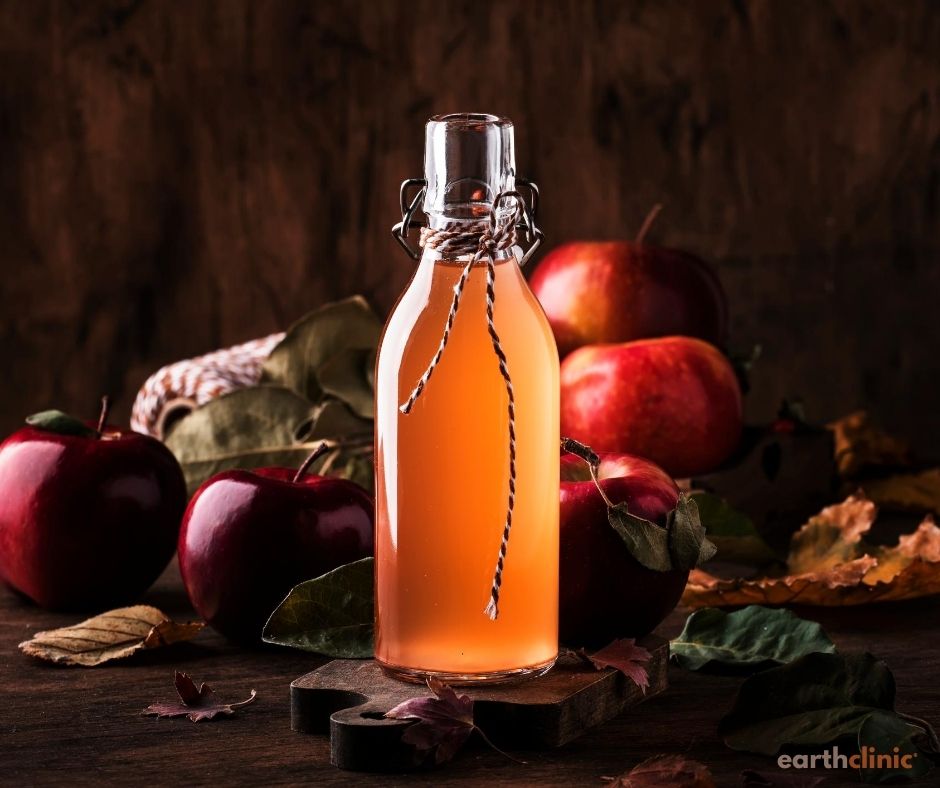
Here are step-by-step instructions on how to make Apple Cider Vinegar, our most popular home remedy!
Organic apple cider vinegar has so many benefits that people are anxious to try it, but they cannot always buy it locally. If you live where organic apple cider vinegar is difficult to find, try making it at home. Here's a recipe we found on the web to make apple cider vinegar! If you have different instructions, please send them our way!
Making Apple Cider Vinegar at Home
Two factors require special attention when making vinegar at home: oxygen supply and temperature. Oxygen is spread throughout the mixture by stirring it daily and by letting air reach the fluid through a cheesecloth filter, which is used in place of a regular lid. The temperature of fermenting cider should be kept between 60 and 80 degrees Fahrenheit (F). Lower temperatures do not always produce a usable vinegar, and higher ones interfere with the formation of the "mother of vinegar." Mother of vinegar is a mat that forms on the bottom of fermenting wine that has gone bad.
Do not use a metal container when making vinegar; acid in the mixture will corrode metal or aluminum objects. Glass, plastic, wood, enamel, or stainless steel containers should be used for making or storing vinegar. The same holds true for making or storing foods that have more than 1 Tablespoon of vinegar in the recipe.
Steps for Making Apple Cider Vinegar
The following steps must be followed to make a high-quality cider vinegar:
1) Make a clean cider from ripe apples.
2) Change all of the fruit sugar to alcohol. This is called "yeast fermentation."
3) Change all of the alcohol to acetic acid. This is called "acetic acid fermentation."
4) Clarify the acetic acid to prevent further fermentation and decomposition.
Step 1--Making Cider
Cider is made from the winter and fall varieties of apples (summer and green apples do not contain enough sugar). Fruit should be gathered, then washed well to remove debris. Crush the fruit to produce apple pulp and strain off the juice. Use a press or cheesecloth for straining.
Adding yeast to activate fermentation is not essential, but will speed up the process. Special cultivated yeasts are available for this purpose at wine-making shops and biological labs--bread yeasts are not recommended. To make a starter, crumble one cake of yeast into one quart of cider. This makes enough starter for 5 gallons of cider; double the recipe proportionately when making more.
Steps 2 and 3--Making Alcohol and Acetic Acid
Pour all of the liquid into one or more containers to about three-quarters capacity; do not close the lids on the containers. Stir the mixtures daily. Keep the containers away from direct sunlight and maintain the temperature at 60 to 80 degrees F. Full fermentation will take about 3 to 4 weeks. Near the end of this period, you should notice a vinegar-like smell. Taste samples daily until the desired strength is reached.
Step 4--Filtering
When the vinegar is fully fermented, filter the liquid through several layers of fine cheesecloth or filter paper--a coffee filter works well for this. This removes the mother of vinegar, preventing further fermentation or spoilage of the product.
Storing Your Vinegar
The vinegar is now ready for storage in separate, capped containers. Stored vinegar will stay in excellent condition almost indefinitely if it is pasteurized. To pasteurize, heat the vinegar before pouring it into sterilized bottles, or bottle, then place in a hot water bath. In both cases, the temperature of the vinegar must reach at least 140 degrees F to sterilize the product, and should not exceed 160 degrees F. Use a cooking thermometer to ensure the correct temperature is met. Cool the containers and store at room temperature out of direct sunlight.
Flavored Vinegar
Flavoring can be added to homemade vinegar just before bottling. Good examples of additives include green onion, garlic, ginger, or any combination of dried or fresh herbs. To make flavoring, place material in a small cheesecloth bag and suspend in the vinegar until desired strength is reached. This will take about 4 days, except for garlic, which takes only 1 day. For every 2 cups of vinegar, use one of the following: 1/2 cup crushed fresh herbs, 1 tablespoon of dried herbs, 2 large cloves of garlic, or 8 small green onions. Other good flavorings include tarragon, basil, nasturtium, chives, mint, chervil, borage, hot chilies, and raspberries. Adjust the amounts to taste, but be careful not to overload the vinegar. Too much vegetable matter can destroy the acid and ruin the preservative quality of the vinegar.
Some flavorings may not go well with cider vinegar's distinct taste and color. When flavoring store-bought vinegar, use more delicate or decorative flavors. When flavoring store-bought vinegar, you will still need to pasteurize it and use sterile bottles.
Flavored vinegars taste great and have a beautiful color, making them excellent for use in salads. You will be tempted to display flavored vinegar; however, be sure to keep your bottles out of direct sunlight, which will destroy the flavor, acidity, and color of the vinegar.
Uses for Homemade Cider Vinegar
Because the acidity of homemade vinegars will vary, do not use them in foods to be canned or stored at room temperature. Homemade vinegar is, however, excellent in salads, cooking, or freezer and refrigerator pickled products.
Prepared by Christine Nicholas, Intern Doris Herringshaw, Extension Agent, Family and Consumer Sciences
This information comes from the following website:
The Ohio State University
Extension Human Nutrition
1787 Neil Avenue, Columbus, OH 43212



